 Menu
Menu
|
School University (1), Azuni (2), Castelvė (3), Spano (4) |
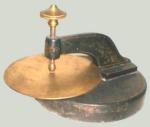 (2) |
||
|
Function To show the modes of a vibrant plate. | |||
|
|||
|
Description (2) A brass chuck is fixed on a round and heavy basis. The glass or brass plates are fixed to the chuck for the experiments in the vibrating plates. Once the plate is fixed and strew with fine sand, it is made to vibrate with a violin bow, so that we obtain interference patterns. | |||
|
School Spano |
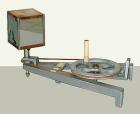
|
||
|
Function To use with the manometric capsule. |
|||
|
|||
|
Description The four flat mirrors are held by a prismatic frame of mahogany wood, rotating on its own axe and ending ends with a cone. The mirror are fixed with four strips of brass at right angles and fixed with screws. A great speed of rotation is not required to observer virtual images of the vibrant flames, and in certain case it is enough to move the frame with hand. If the mirror is very close, it is convenient to shield the flame from the air currents caused by the motion of the mirror with a glass plane. | |||
|
School University |
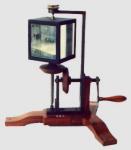
|
||
|
Function To observe the vibrant flames. |
|||
|
|||
|
Description A cube can rotate vertically along one of its axes. The rotation is set by hand with a crank and gear drive. Four mirrors are placed on the vertical sides. The apparatus is used to study the sound through the sound flames. | |||
|
School Spano (1), Castelvė (2), Pellegrini (3) |
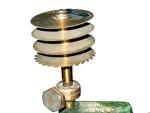
|
||
|
Function It produces sounds tuned one with the other. | |||
|
|||
|
Description Also this apparatus is an accessory of the rotary apparatus. It is formed by four brass disks with pointed isosceles gear teeth in numbers of 80, 60, 50, 40, fitted on the same axe that ends with a cone. If the wheels rotate with a uniform motion, by drawing a thin cardboard near the gear teeth, we have vibrations proportional to the numbers 8, 6, 5, 4 and the corresponding sounds are perfectly tuned. | |||
|
School Spano (1), Pellegrini (2) |
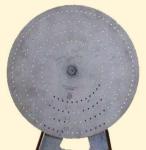
|
||
|
Function If the speed of rotation is constant we obtain a perfect tune between the emitted sounds. |
|||
|
|||
|
Description If is formed by a disk of aluminium with a set of four holes in number of 80, 60, 50, 40, corresponding to the perfect tune. After applying the siren to the axe of the rotary apparatus, we make it to rotate with constant speed, and we aim a powerful flow of air at the holes. | |||
|
School Castelvė (1), Spano (2) |
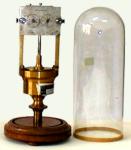 (1) (1)
|
||
|
Function We can obtain sound with different frequencies. |
|||
|
|||
|
Description Model with revolution counter spring start and stop instantaneously. To keep the sound pitch given by the siren constant, it is necessary to have bellows with a pressure regulator. The number of complete vibrations, that corresponds to the emitted sound, is given by the product of the number of the holes by the number of the turns divided by the duration of the sound in seconds. | |||
|
School Spano |
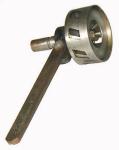
|
||
|
Function We can obtain sounds of different frequencies. |
|||
|
|||
|
Description The siren is formed by a disk with nozzles that turns and provoke the emission of sounds that become shriller as the rotation speed increases. With a pivot welded to the disk the siren can be applied to the rotating apparatus. | |||
|
School Castelvė |

|
||
|
Function To show that sound does not propagate in the vacuum. | |||
|
|||
|
Description It is a glass balloon that can be connected to a pneumatic pump. In this balloon there is a bronze bell, connected to the metallic escutcheon with a low sound conductivity substance (skin, rubber). The intensity of the sound decreases when the pressure decreases. | |||
|
School University |
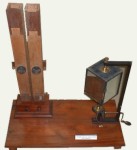
|
||
|
Function Studying the interference of the sound waves. | |||
|
|||
|
Description This apparatus is due to König. It is formed by a rotating cubic mirror and by a bellows on which we can engage two of Konigs sound pipes. | |||
|
School Spano |

|
||
|
Function Interference of sound waves. | |||
|
|||
|
Description The two pipes stay vertically and the one with variable length follows to a guide bearing with a celluloid scale. The annexe accessories (two adapters for rubber tube and two three ways tubes) allow the quick modification of the apparatus for different experiments in interference. | |||